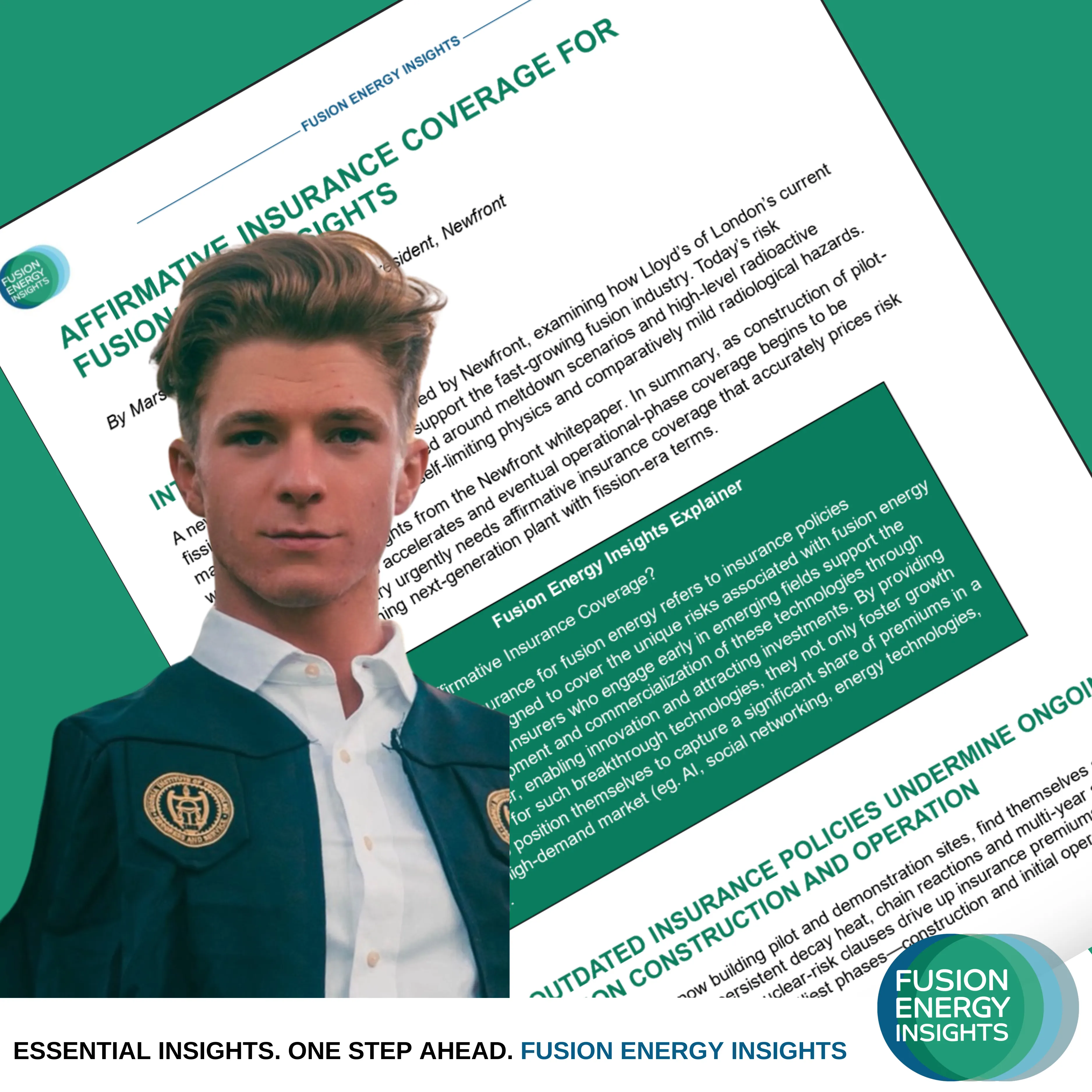Affirmative Insurance Coverage for Fusion: 3 Key Insights
By Marshall Williams, Associate Vice President, Newfront
Introduction
A new whitepaper has been published by Newfront, examining how Lloyd’s of London’s current fission-focused exclusions fail to support the fast-growing fusion industry. Today’s risk management strategies—designed around meltdown scenarios and high-level radioactive waste—do not reflect fusion’s self-limiting physics and comparatively mild radiological hazards.
Here are three key insights from the Newfront whitepaper. In summary, as construction of pilot-scale fusion machines accelerates and eventual operational-phase coverage begins to be planned, the industry urgently needs affirmative insurance coverage that accurately prices risk and avoids burdening next-generation plant with fission-era terms.

Fusion Energy Insights Explainer
What is Affirmative Insurance Coverage?
Affirmative insurance for fusion energy refers to insurance policies specifically designed to cover the unique risks associated with fusion energy technologies. Insurers who engage early in emerging fields support the rapid development and commercialization of these technologies through risk-transfer, enabling innovation and attracting investments. By providing coverage for such breakthrough technologies, they not only foster growth but also position themselves to capture a significant share of premiums in a new, high-demand market (eg. AI, social networking, energy technologies, etc.).
Here are three key insights:
1. Outdated insurance policies undermine ongoing fusion construction and operation
Many developers who are now building pilot and demonstration sites, find themselves subject to policy exclusions that assume persistent decay heat, chain reactions and multi-year spent fuel storage. As a result of this, legacy nuclear-risk clauses drive up insurance premiums, forcing additional capital outlays during the costliest phases—construction and initial operation, especially for first-of-a-kind risks.
By contrast, fusion’s risk drivers are based on:
- Neutron activation of structural materials: Energetic neutrons activate reactor walls, but with relatively short-lived isotopes compared to fission wastes.
- Tritium handling and storage: While tritium is radioactive, it has a low-energy beta decay and only a 12-year half-life, requiring modest shielding and standard inventory controls.
- Industrial hazards at high temperatures: Fusion plants, like other thermal power facilities, need robust mechanical integrity for vacuum vessels, cryogenic loops and associated systems.
Therefore, without policies that reflect these technical realities, construction-phase and operational-phase costs for fusion will balloon. Higher insurance premiums and contractual limitations eat into funds needed to finalize plant designs and validate power-generating performance—slowing the broader push toward fusion commercialisation.
2. The fusion market is evolving and insurers must adapt
Private investments in fusion now exceed $12 billion, with new projects attracting major backers worldwide. Insurers, such as Chubb and Munich Re, have begun adapting coverage for advanced plants. Surplus lines markets in Bermuda are also exploring first-of-a-kind solutions for fusion machines, aiming to recognise meltdown-free physics.
From a risk management standpoint, Affirmative Coverage for fusion would:
- Eliminate blanket “nuclear” exclusions: Replace meltdown-based triggers with data-driven modelling for partial-load plasma tests and other relevant fusion failure modes.
- Incorporate lower radiological risk: A layered framework acknowledges short half-lives of activated material and minimal risk of large-scale releases, unlike fission fuel rods.
- Capture ancillary industrial exposures: Address high-voltage systems, vacuum handling, thermal loops and specialised tritium-processing lines under property and casualty policies.
For Lloyd’s in particular, maintaining one-size-fits-all nuclear exclusions puts it at risk of losing business to rivals offering specialised coverage for fusion’s distinct risk profile.
3. Regulatory advances demand affirmative coverage
Regulators globally are codifying rules that separate fusion oversight from fission. Examples include:
- US Nuclear Regulatory Commission (NRC) are evaluating many fusion concepts under byproduct material rules (10 CFR Part 30) rather than the far more stringent Part 50 or 52 frameworks for nuclear power reactors.
- UK regulators treat fusion akin to high-energy accelerator facilities, focusing on localised radiation shielding and neutron flux management.
- Canadian Nuclear Safety Commission (CNSC) is tailoring Class II Nuclear Facilities rules for fusion, emphasising tritium operations and simplified radiation control.
These developments confirm meltdown-focused coverage is excessive. To keep pace with new licensing norms—and the safer design features they reflect—Lloyd’s and other insurers must transition to an affirmative approach that sets clear coverage parameters and liability limits aligned with real-world fusion hazards.
Conclusion
As fusion projects outgrow laboratory prototypes into large-scale construction, the insurance industry must move beyond fission-era exclusions that inflate premiums and deter financing. Updating nuclear-risk clauses to reflect short-lived activation waste and practical tritium management and aligning policy structures with modern regulations, will enable Lloyd’s and other carriers to unlock substantial underwriting opportunities—and power the future of clean, reliable baseload energy.
For a deeper set of policy recommendations, read Newfront’s complete whitepaper here.
